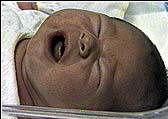The History of Circumcision - Male Genital Mutilation
From the website of The 1911 Encyclopaedia Love to Know
CIRCUMCISION (Lat. circum, round, and caedere, to cut), the cutting off of the foreskin. This surgical operation, which is commonly prescribed for purely medical reasons, is also art initiation or religious ceremony among Jews and Mahommedans, and is a widespread institution in many Semitic races. It remains, with Jews, a necessary preliminary to the admission of proselytes, except in some Reformed communities. The origin of the rite among the Jews is in Genesis (xvii.) placed in the age of Abraham, and at all events it must have been very ancient, for flint stones were used in the operation (Exodus iv. 25; - Joshua v.2). The narrative in Joshua implies that the custom was introduced by him, not that it had merely been in abeyance in the Wilderness. At Gilgal he rolled away the reproach of the Egyptians by circumcising the people.
This obviously means that whereas the Egyptians practised circumcision the Jews in the land of the Pharaohs did not, and hence were regarded with contempt. It was an old theory (Herodotus ii. 36) that circumcision originated in Egypt; at all events it was practised in that country in ancient times (Ebers, Egypt en und die Bucker IvIosis, i. 278-284), and the same is true at the present day. But it is not generally thought probable that the Hebrews derived the rite directly from the Egyptians. As Driver puts it (Genesis, p. 190): it. is possible that, ~ts Dillmann and Nowack suppose, the peoples of N. Africa and Asia who practised the rite adopted it from the Egyptians, but it appears in so many parts of the world that it must at any rate in these cases have originated independently. In another biblical narrative (Exodus iv. 25) Moses is subject to the divine anger because he had not made himself a bridegroom of blood, that is, had not been circumcised before his marriage.
The rite of circumcision was practised by all the inhabitants of Palestine with the exception of the Philistines. It was an ancient custom among the Arabs, being presupposed in the Koran. The only important Semitic peoples who most probably did not follow the rite were the Babylonians and Assyrians (Sayce, Babyl. and Assyrians, p.47). Modern investigations have brought to light many instances of the prevalence of circumcision in various parts of the world. These facts are collected by Andre and Ploss, and go to prove that the rite is not only spread through the Mahommedan world (Turks, Persians, Arabs, &~.),but also is practised by the Christian Abyssinians and the Copts, as well as in central Australia and in America. In central Australia (Spencer and Gillen, pp. 212-386) circumcision with a stone knife must be undergone by every youth before he is reckoned a full member of the tribe or is permitted to enter on the married state. In other parts, too (e.g. Loango), no uncircumcised man may marry.
Circumcision was known. to the Aztecs (Bancroft, Native Races, vol. iii.), and is still practised by the Caribs of the Orinoco and the Tacunas of the Amazon. The method and period of the operation vary in important particulars. Among the Jews it is performed in infancy, when the male child is eight days old. The child is named at the same time, and the ceremony is elaborate. The child is carried in to the godfather (sandek, a hebraized form of the Gr. ci5vreevos, godfather, post-class.), who places the child on a cushion, which he holds on his knees throughout the ceremony. The operator (mohel) uses a steel knife, and pronounces various benedictions before and after the rite is performed (see S. Singer, Authorized Daily Prayer Book, pp. 304-307; an excellent account of the domestic festivities and spiritual joys associated with the ceremony among medieval and modern Jews may be read in S. Schechters Studies in Judaism, first series, pp.351 seq.). Some tribes in South America and elsewhere are said to perform the rite on the eighth day, like the Jews. The Mazequas do it between the first and second months. Among the Bedouins the rite is performed on children of three years, amid dances and the selection of brides (Doughty, Arabia Deserta, i. 340); among the Somalis the age is seven (Reiniscb, Somalisprache, p. 110). But for the most part the tribes who perform the rite carry it out at the age of puberty, Many facts bearing on this point are given by B. Stade in Zeitschrift fur die altiest. Wissenschaft, vi. (1886) pp. 132 seq.
The significance of the rite of circumcision has been much disputed. Some see in it a tribal badge. If this be the true origin of circumcision, it must go back to the time when men went about naked. Mutilations (tattooing, removal of teeth and so forth) were tribal marks, being partly sacrifices and partly means of recognition (see MUTILATION). Such initiatory rites were often frightful ordeals, in which the neophytes courage was severely tested (Robertson Smith, Religion of the Semites, p. 310). Some regard circumcision as a substitute for far more serious rites, including even human sacrifice. Utilitarian explanations have also been suggested. Sir R. Burton (Memoirs Anthrop. Soc. ~. 318) held that it was introduced to promote fertility, and the claims of cleanliness have been put forward (following Philos example, see ed. Mangey, i. 210). Most probably, however, circumcision (which in many tribes is performed on both sexes) was connected with marriage, and was a preparation for connubium. It was in Robertson Smiths words originally a preliminary to marriage, and so a ceremony of introduction to the full prerogative of manhood, the transference to infancy among the Jews being a later change. On this view, the decisive Biblical reference would be the Exodus passage (iv. 25), in which Moses is represented as being in danger of his life because he had neglected the proper preliminary to marriage. In Genesis, on the other hand, circumcision is an external sign of Gods covenant with Israel, and later Judaism now regards it in this symbolical sense. Barton (Semitic Origins, p. 100) declares that the circumstances under which it is performed in Arabia point to the origin of circumcision as a sacrifice to the goddess of fertility, by which the child was placed under her protection and its reproductive powers consecrated to her service. But Barton admits that initiation to the connubium was the primitive origin of the rite.





